Visual Inspections of Commercial Jet Engines

Background
Millions of commercial aircraft fly passengers and goods to thousands of destinations throughout the world every day. For the commercial aircraft carrying passengers and precious carriages in very harsh environments, the inspection and maintenance for safe operation are crucial. Periodic inspections of aircraft engines are essential.
Certain areas within the engine have access ports to facilitate visual inspection with endoscopes. However, there are various difficulties an inspector may face when attempting to conduct an engine inspection precisely and in a timely manner.
Challenges and Solutions
(1) Inspected parts in various sizes and locations
Challenge:
Commercial jets are equipped with turbofan engines, with engine size varying from small turbines for regional jets to large turbines for larger, inter-continental airliners. Furthermore, there are many different parts to be inspected within each engine, such as turbine blades, compressor blades and the combustion chamber. It is important when conducting a smooth and accurate inspection, to choose the optimal endoscope and related accessories by engine type and engine part.
Basic structure of a turbofan engine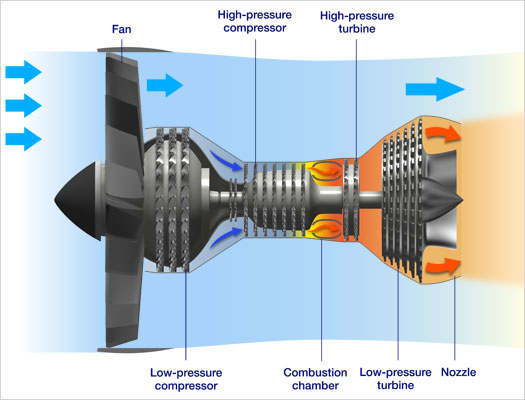
Solution:
One IPLEX videoscope can cover various demands for aircraft engine inspections by just changing the optical adaptors. The following chart indicates the recommended inspection equipment by engine size and part:
| Engine size | Inspected area | Suitable videoscope | Suitable optical adaptor | Remark |
| Small | Low-pressure compressor blades | IPLEX with 4 mm outer diameter | AT120S/FF | |
| High-pressure compressor blades | AT120S/FF | |||
| Combustion chamber | AT120D/FF | |||
| AT120D/NF | For observation of tiny cracks in a magnified view | |||
| High-pressure turbine blades | AT120S/FF | |||
| Low-pressure turbine blades | AT120S/FF | |||
| Medium | Low-pressure compressor blades | IPLEX with 6 mm outer diameter with a rigid sleeve | AT120D/FF | |
| High-pressure compressor blades | AT80S/FF and AT120S/FF | AT120S/FF with a wide field of view enables to observe the entire blade. | ||
| Combustion chamber | IPLEX with 6 mm outer diameter | AT80D/FF and AT120D/FF | - The entire inspection is available by inserting the scope into a combustion chamber all the way around. - A guide tube with a bend assists the inspections of the fuel injection nozzles and the innner/outer walls. | |
| High-pressure turbine blades | IPLEX with 6 mm outer diameter with a rigid sleeve | AT80D and AT120D types | A rigid sleeve is unnecessary when inserting the scope from the combustion chamber and observing through the gap at the turbine nozzle. | |
| AT120D/NF | For inspection of hair cracks on the leading edges | |||
| Low-pressure turbine blades | AT120D/FF | |||
| Large | - The suitable videoscope and optical adaptors are same as those for the medium-sized engine inspections. - The IPLEX of 8.5 mm outer diameter is recommended when all-round inspections are required due to the risk that the 6mm scope insertion tube may be caught in a gap between the rotor and the stator. | |||
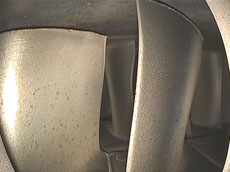
High-Pressure Compressor
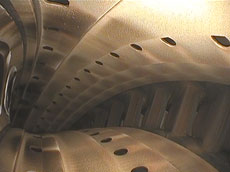
Combustion Chamber
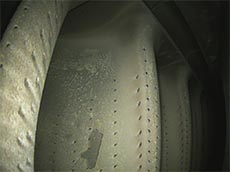
High-Pressure Turbine
(2) Laborious operation to rotate the engine shaft
Challenge:
Operators need to inspect hundreds of blades, which are located at several turbine/compressor stages and mounted on the shaft during the aircraft engine inspection. To conduct the inspection, a collaborative work is required where one operator manually rotates the shaft while another inspects the blade condition. This work not only requires an additional operator for the shaft rotation, but also tends to cause insufficient inspection of the turbine.
Solution:
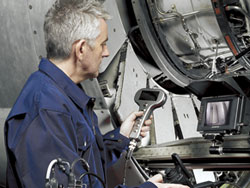
The engine specific OTT Engine Turning Tools can automatically rotate the shaft with high-pressure compressor/turbine blades at a preferred speed, enabling an inspector to accurately and thoroughly conduct both the shaft rotating and blade inspection operations without the need for a second person.
(3) Time-consuming inspection analysis and report generation
Challenge:
Throughout the inspection, recording a large number of blade images is often the case for inspection analysis and report generation, but within this environment, images are very similar each other and it is sometimes impossible to identify blade types by reviewing images. Thus, many operators experience difficulty and frustration when attempting to find and sort intended images from a large volume of very similar images.
Solution:
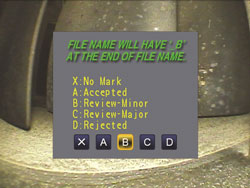
Our Inspection Assist Software enables an inspector to record images while categorizing them by inspected stage and putting diagnosis onto the images by way of standardized comment.
After the inspection, the inspector/reporter can efficiently analyze the recorded images and immediately create a report, just by selecting desired images with one-click operation.
Key Benefits with Olympus
(1) IPLEX videoscopes optimized for aircraft engine inspections
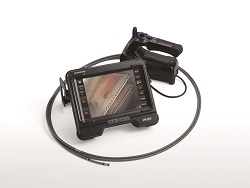
- Bright, high-resolution images faithfully and clearly reproduce very small defects within a gas turbine for accurate analysis.
- The insertion tube with well-tuned stiffness and flexibility, and often TaperedFlex technology, facilitates insert-ability for smooth all-round inspections of the shroud and combustion chamber. It is also exceptionally resilient and can withstand repeated use against sharp blades and other metal surfaces.
- TrueFeel articulation provides exceptional control and precision to improve work efficiency.
- Stereo Measurement technology is suitable for defect measurement on engine blades located in narrow and hard-to-approach areas.
(2) Optimal observation view for various turbine stages
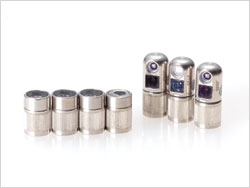
In aircraft engine inspections, demands for observation are different depending on inspected parts and locations. Demands range from wide viewing perspective being required to inspect a combustion chamber to the observation of high-pressure turbines and compressors, which are conducted in narrow spaces where a scope tip of an endoscope cannot be bent. Olympus IPLEX tip adaptors provide full lensing systems with some of the shortest tip lengths in the industry. From near focus, to far focus; direct view to side view and varying angles of view, Olympus’ comprehensive range of optical tip adaptors covers the diverse inspection demands within this environment.
Please click here to see How to choose optical tip adapters for the industrial videoscopes >>
(3) Systems to support efficient and accurate inspections
Olympus provides effective systems to increase your work efficiency of aircraft engine inspections. The OTT Engine Turning Tools allow an inspector to conduct inspections of high-pressure compressor/turbine blades single handedly. The InHelp Inspection Assist Software streamlines all aspects of the inspections and significantly reduces the time for post-inspection work.
